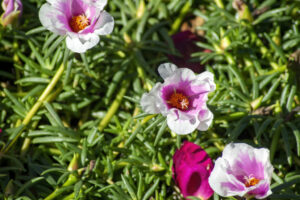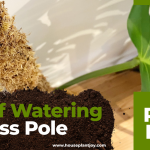HousePlantJoy is supported by our audience. When you purchase through one of our links, we may earn a small affiliate commission. As an Amazon Associate I earn from qualifying purchases. Your cost is not affected.
==================
Hey there, green thumbs! Are you tired of high-maintenance flowers that need constant attention to keep them alive? Want to add a pop of color to your outdoor space without all the fuss? Look no further than the moss rose or portulaca. These tough little plants are hardy enough to survive even in the driest and hottest conditions, making them perfect for sunny gardens or patios. In this article, we’ll dive into the beauty and benefits of growing some fabulous moss roses, and I’ll give you some tips and tricks to make your budding garden flourish. So, grab a cool drink, and let’s jump into the wonderful world of moss roses!
Grow Moss Roses Indoors and Outdoors
You can grow moss roses as houseplants with some careful considerations. Although usually an outdoor plant, the rose enthusiast may consider growing these beautiful specimens indoors. Interested in more roses for indoor growing? See our article on Roses As Houseplants.
Grow Moss Roses as Bedding Plants
Moss roses, with their succulent leaves, make beautiful bedding plants and are easily found in nurseries and many home improvement stores. These hardy plants hold their flowers throughout the season, often even during droughts.
Resembling miniature roses, they come in many varieties. In fact, their colors range from orange, yellow, red, bright pink, white, and cream, to variegated colors. With semi-double or full-double flowers, they provide a light beauty to walkways and garden beds.
The purslane family Portulacaceae contains less than 100 species and includes the genus Portulaca grandiflora. The Moss roses stay small, usually under 8 inches tall. However, given space to spread, they will cover up to 2 feet. The dense mat they form creates an excellent groundcover.
Grow Moss Roses as Houseplants
However, these hardy annuals may also be grown as houseplants. Some use them in mixed boxes to create a variegated color and texture design. Others allow them to trail from hanging baskets.
And whichever pot type you choose, these hardy plants will provide a beautiful display of dainty blooms for many weeks. Of course, you need to ensure they have the proper growing conditions. This includes a similar environment to an outdoor bed.
Our discussion encompasses the ideal conditions to grow Moss Roses for indoor or outdoor uses.
Video credit: @urbangardeningofficial
Grow Moss Roses and More in This Article:
- How to Grow
- Light
- Soil
- Water
- Temperature and Humidity
- Fertilizer
- Varieties
- Pruning
- Growing From Seeds
- Common Pests
When You Grow Moss Roses, in Summary
Botanical Name: Portulaca grandiflora
Common Name: Moss rose
Plant Type: Annual flower
Propagate from: Seed, cuttings
Mature Size: 3 to 8 inches tall; up to 12 to 24 inches wide
Sun Exposure: Full sun
Soil Type: Sandy, well-drained; will tolerate moist to dry soil
Soil pH: 5.5 to 7.0
Bloom Time: Early summer to frost
Flower Color: White, cream, orange, yellow, red, pink, purple, variegated
Hardiness Zones: 2 through 11
Native Area: South America
Grow Moss Roses Flowers
To grow moss rose plants, they need containers. In fact, their low demand for water makes them ideal for containers, including hanging baskets. While they thrive in soil, they do equally well on your patio or deck. Consider them in hanging baskets to enjoy the beautiful trailing vine adorned with petite roses.
In the ground, the Moss Rose is a well-behaved ground cover. Because it is not invasive like many ground covers, it stays within the bounds given. As such, it is quite useful in a small garden area, fairy garden, or a rock garden. You might even use it on a stone or rock wall, allowing it to trail over the edges.
Light
To grow moss rose in bright sunlight, it needs six to eight hours of full sun. In shade, they may live, but may not flower much, if at all. They tolerate cloudy days but the flowers usually close without the sun. They emerge again when the sun returns.
For indoor plants, this means they need a window view with plenty of sun. Alternatively, consider using a sunlamp to supplement the needed light. You might even consider putting the sunlamp on a timer to imitate the true sun.
Soil
Soil needs must be met for the Moss Rose and other plants. They thrive in a well-drained soil. Sandy and rocky soil work, too. However, clay soil will kill these beautiful plants and other plants.
Water
While Moss Rose plants tolerate some drought, they are not arid plants. They need regular watering. If they become somewhat dry, they usually recover. But we see the best performance with regular watering. For outside, consider a drip irrigation system to avoid water-logging the flowers. Indoor and container plants should be watered when the soil begins to dry out but is not completely dry.
Temperature and Humidity
The Moss Rose is native to Brazil, Uruguay, and Argentina. Therefore, they love heat and can tolerate dry conditions. In fact, Moss Rose plants often are used for xeriscaping for these characteristics.
Grow Moss Roses With Fertilizer
The Moss rose plant demands little feeding. Use a slow-release fertilizer labeled for flowers. Feed just twice a year, usually once every 6 months.
Varieties and Companions
Moss rose plants make good companions for flowers that also thrive in hot, dry, sunny gardens. Gomphrena flowers, zinnias, and dusty miller grow well when planted with a moss rose border.
The Moss rose provides a good gap-filling after spring bulbs and foliage finish blooming. The Moss Rose forms a mat over the now resting bulbs which protects them without harm. And, because they don’t require large volumes of water, they don’t cause the bulbs to rot, either.
Consider these beautiful portulaca varieties:
Afternoon Delight: These close their blooms later in the evening, allowing for longer enjoyment.
Duet series: Duet’s name comes from it’s bi-color flowers in yellow and red or yellow and rose
Fairy Tale series: These resemble bomb-type peonies. They have a pom pom like center with flat petals that flare around the edges
Happy Hour: This variety blooms earlier than most, due to a shortened photo-period requirement.
Margarita series: Rosita variety is an All-American selections winner in this series
Sundance: Slightly larger flowers than other varieties hosting on mounding, upright plants make this variety unique.
Sundial series: This variety is an excellent choice for Northwest gardeners and some indoor placement, as it tolerates cloudy days and cool weather
Yubi series: Variety of color marks Yubi with single-petaled flowers in eight color choices.
Pruning
These plants will bloom all season long, but sometimes need a little pruning when they look spindly. At this point, just trim back the plants to provide a stronger stem point. Then fertilize with a flower-type fertilizer. You should see stronger stems and new flowers emerging.
Keep the Flowers Coming
Your Moss Rose plants produce flowers throughout the growing season. However, to ensure the multitudes they are capable of, pinch back the flowers as they die back. This encourages new growth and more flowers.
Grow Moss Roses From Seeds
People find it easy to grow moss rose. Just remember that these tiny seeds need light to germinate. Therefore, it’s important that you sow lightly to avoid over-seeding.
For outdoor plants, start the seeds indoors about eight weeks before the last frost date. Alternatively, you may sow them directly in the ground after your last frost.
Germination takes about two weeks if the weather is warm and they receive sunlight. If you have grown these plants in previous seasons, you may not need to seed again. The Moss Rose plant will self-seed and often produces a large number of seedlings in the spring.
Similarly, to grow in a container indoors, simply plant the seeds. Keep the well-drained soil moist. Ensure that they receive ample direct light. In this manner, you may find that direct seeding provides a very simple method of increasing your houseplants quickly.
While the Moss Rose grows easily from seed, propagation from cuttings also works well.
Common Pests When You Grow Moss Roses
Aphids occasionally attack portulacas, particularly in the spring. To combat them, spray affected plants with insecticidal soap when the temperature is below 85 degrees Fahrenheit.
If the planting area is wet, you may also need to treat for slugs and snails. Use DE, otherwise known as diatomaceous earth, around moss rose plants to prevent infestations. The DE kills insects naturally by drying out their bodies.
Other Concerns
Fungus diseases can occur. Use a general-purpose fungicide in humid weather, and when problems appear.
Stem and root rot can occur. This is a problem in wet soil. To avoid problems, plant in well-draining soil, such as a sandy blend. A slightly elevated planting bed also helps to avoid this problem.
Why Grow Moss Roses
If you live in an area of heat and drought, you will love growing Moss Rose. Also commonly called Portulaca, this tough, yet pretty little plant, needs little moisture to thrive and bloom. It grows well in midsummer’s heat, too.
Native to South America, Moss Rose, or Portulaca, is a hardy annual. It produces vividly colored blooms, in shades of rose, yellow, white, orange, red, purple, and pink. Flower blooms begin to appear in early summer.
Moss Rose grows just four to six inches tall. Place it in front of your flower garden. Try planting Moss Rose as border edging, in rock gardens, as bedding plants or ground cover. They also look good in containers and hanging pots. They’ll be forgiving when you forget to water them.
We Invite You to Grow Moss Roses as Indoor Plants!
And with that, it’s time to say goodbye to our moss roses for now. It’s been so fun exploring everything these hardy little plants have to offer. I hope you’ve learned a lot about growing and maintaining moss roses and you’re inspired to try it out for yourself. These flowers may be low-maintenance, but they’re definitely not low on beauty! Imagine how great it’ll feel when someone compliments you on the stunning colors and blooms in your outdoor space. With a little dedication, creativity and love, you can make an eye-catching garden that’ll impress anyone. So go ahead, grab some moss rose seeds, and make your outdoor space shine with all the vibrant colors of these flowers!
Related Content on Growing Moss Roses
FAQs
Can I plant moss roses in a pot instead of in the ground?
Absolutely! Moss roses grow very well in pots and containers, so you can add some color to your balcony or porch. Just make sure the pot has drainage holes, and use well-draining soil.
How often should I water moss roses?
Moss roses are succulents, which means they store water in their leaves and stems. So, they don’t need a lot of watering. Water them once a week or when the top inch of soil is dry. Overwatering can lead to root rot, so be careful not to overdo it.
Do moss roses attract pollinators like bees and butterflies?
Yes, moss roses produce small, bright-colored flowers that attract pollinators like bees and butterflies. They are also drought-tolerant, which means they will continue to bloom even during dry spells. So, if you want to help pollinators and have a low-maintenance plant, moss roses are a great choice.
Can you please explain moss roses care to me?
Moss roses are relatively low-maintenance plants that require full sun and well-draining soil. They are drought-tolerant, so make sure to water them only when the soil is dry to the touch. Overwatering can lead to root rot and cause damage to the plant. Deadheading the flowers regularly can promote more blooms.
Can I do moss rose indoor care?
While moss roses are typically grown outdoors, they can also be grown indoors as long as they receive enough sunlight. Place them near a sunny window or under a grow light and make sure they have well-draining soil to prevent root rot.
How moss roses grow in places?
To plant moss roses, you can start with seeds or purchase established plants from a nursery. If starting with seeds, plant them in well-draining soil and keep them moist until they germinate. Once they have sprouted, water them regularly and provide plenty of sunlight.
What is the best strategies for growing moss rose plants?
Moss roses are hardy little plants. Hence, they can withstand temperature changes. Because they are like that, they can thrive in hot and dry conditions. They prefer full sun and well-draining soil. They are also drought-tolerant or cannot take in a lot of water. So, when you’re taking care of them, be careful not to overwater. Also, to promote more blooms, deadhead the flowers regularly.
When should I plant moss rose seeds?
Moss rose seeds should be planted in the spring after the last frost. After all, they prefer warm soil, so it’s best to wait until the soil has had a chance to warm up before planting. Make sure to plant them in well-draining soil and keep them moist until they germinate.
How long do moss rose flowers last?
Moss rose flowers typically bloom throughout the summer months and can last for several weeks. Deadheading the flowers can promote more blooms and extend the flowering period.
Does moss rose need full sun?
Yes, moss rose thrives in full sun and requires at least 6 to 8 hours of direct sunlight each day. It is a sun-loving plant that may become weak and fail to produce vibrant flowers if not provided with sufficient sunlight.
Does moss rose spread?
Yes, moss rose can spread and fill in spaces over time, thanks to its self-seeding and rooting stems. It has a tendency to form a dense ground cover if left unchecked, which may be considered invasive in some regions.
Does portulaca need full sun?
Yes, portulaca requires full sun and thrives in hot and sunny conditions. It needs at least 6 to 8 hours of direct sunlight daily to grow and bloom successfully.




















